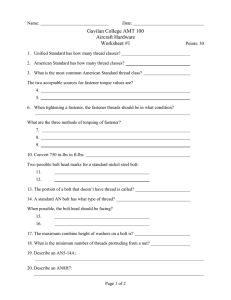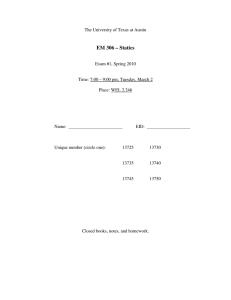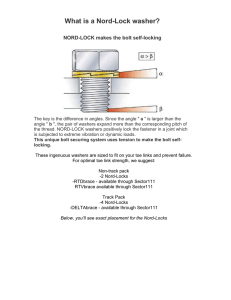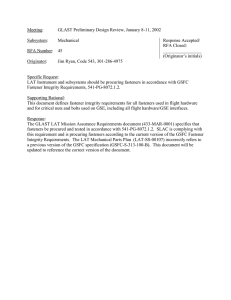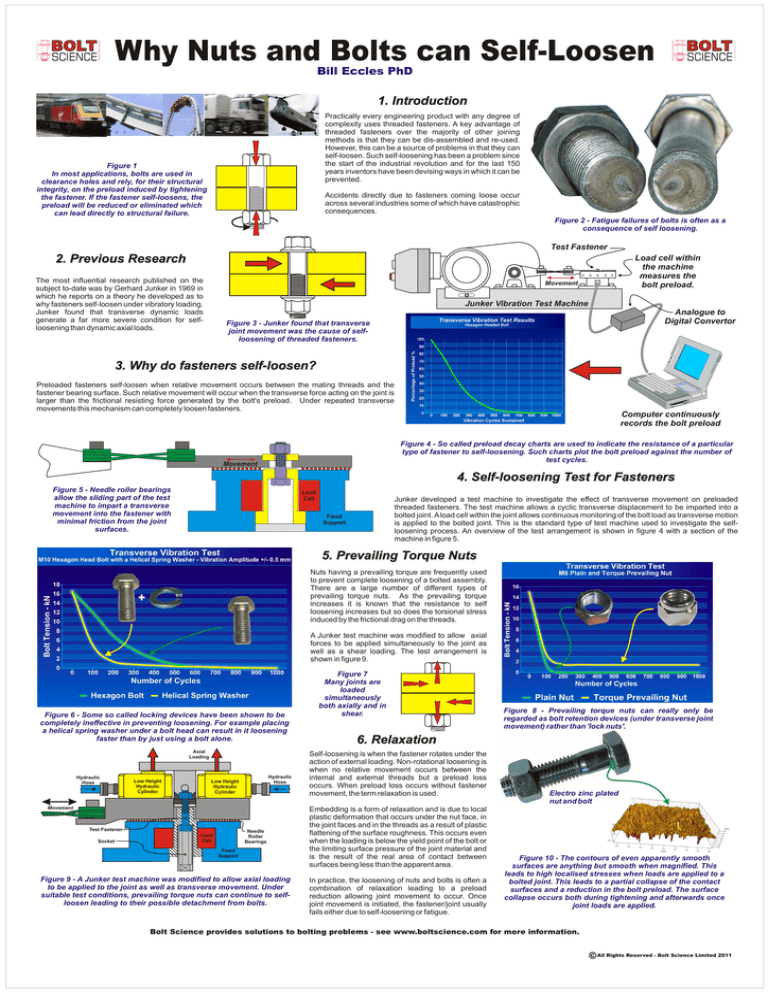
Why Nuts and Bolts can Self-Loosen
BOLT
SCIENCE
BOLT
SCIENCE
Bill Eccles PhD
1. Introduction
Practically every engineering product with any degree of
complexity uses threaded fasteners. A key advantage of
threaded fasteners over the majority of other joining
methods is that they can be dis-assembled and re-used.
However, this can be a source of problems in that they can
self-loosen. Such self-loosening has been a problem since
the start of the industrial revolution and for the last 150
years inventors have been devising ways in which it can be
prevented.
Figure 1
In most applications, bolts are used in
clearance holes and rely, for their structural
integrity, on the preload induced by tightening
the fastener. If the fastener self-loosens, the
preload will be reduced or eliminated which
can lead directly to structural failure.
Accidents directly due to fasteners coming loose occur
across several industries some of which have catastrophic
consequences.
Figure 2 - Fatigue failures of bolts is often as a
consequence of self loosening.
Test Fastener
2. Previous Research
The most influential research published on the
subject to-date was by Gerhard Junker in 1969 in
which he reports on a theory he developed as to
why fasteners self-loosen under vibratory loading.
Junker found that transverse dynamic loads
generate a far more severe condition for selfloosening than dynamic axial loads.
Load cell within
the machine
measures the
bolt preload.
Movement
Junker Vibration Test Machine
Analogue to
Digital Convertor
Figure 3 - Junker found that transverse
joint movement was the cause of selfloosening of threaded fasteners.
3. Why do fasteners self-loosen?
Preloaded fasteners self-loosen when relative movement occurs between the mating threads and the
fastener bearing surface. Such relative movement will occur when the transverse force acting on the joint is
larger than the frictional resisting force generated by the bolt's preload. Under repeated transverse
movements this mechanism can completely loosen fasteners.
Computer continuously
records the bolt preload
Figure 4 - So called preload decay charts are used to indicate the resistance of a particular
type of fastener to self-loosening. Such charts plot the bolt preload against the number of
test cycles.
Movement
4. Self-loosening Test for Fasteners
Figure 5 - Needle roller bearings
allow the sliding part of the test
machine to impart a transverse
movement into the fastener with
minimal friction from the joint
surfaces.
Load
Cell
Junker developed a test machine to investigate the effect of transverse movement on preloaded
threaded fasteners. The test machine allows a cyclic transverse displacement to be imparted into a
bolted joint. A load cell within the joint allows continuous monitoring of the bolt load as transverse motion
is applied to the bolted joint. This is the standard type of test machine used to investigate the selfloosening process. An overview of the test arrangement is shown in figure 4 with a section of the
machine in figure 5.
Fixed
Support
5. Prevailing Torque Nuts
Nuts having a prevailing torque are frequently used
to prevent complete loosening of a bolted assembly.
There are a large number of different types of
prevailing torque nuts. As the prevailing torque
increases it is known that the resistance to self
loosening increases but so does the torsional stress
induced by the frictional drag on the threads.
A Junker test machine was modified to allow axial
forces to be applied simultaneously to the joint as
well as a shear loading. The test arrangement is
shown in figure 9.
Figure 6 - Some so called locking devices have been shown to be
completely ineffective in preventing loosening. For example placing
a helical spring washer under a bolt head can result in it loosening
faster than by just using a bolt alone.
Axial
Loading
Hydraulic
Hose
Low Height
Hydraulic
Cylinder
Hydraulic
Hose
Low Height
Hydraulic
Cylinder
Moving
Support
Movement
Test Fastener
Socket
Needle
Roller
Bearings
Load
Cell
Fixed
Support
Figure 9 - A Junker test machine was modified to allow axial loading
to be applied to the joint as well as transverse movement. Under
suitable test conditions, prevailing torque nuts can continue to selfloosen leading to their possible detachment from bolts.
Figure 7
Many joints are
loaded
simultaneously
both axially and in
shear.
Figure 8 - Prevailing torque nuts can really only be
regarded as bolt retention devices (under transverse joint
movement) rather than 'lock nuts'.
6. Relaxation
Self-loosening is when the fastener rotates under the
action of external loading. Non-rotational loosening is
when no relative movement occurs between the
internal and external threads but a preload loss
occurs. When preload loss occurs without fastener
movement, the term relaxation is used.
Embedding is a form of relaxation and is due to local
plastic deformation that occurs under the nut face, in
the joint faces and in the threads as a result of plastic
flattening of the surface roughness. This occurs even
when the loading is below the yield point of the bolt or
the limiting surface pressure of the joint material and
is the result of the real area of contact between
surfaces being less than the apparent area.
In practice, the loosening of nuts and bolts is often a
combination of relaxation leading to a preload
reduction allowing joint movement to occur. Once
joint movement is initiated, the fastener/joint usually
fails either due to self-loosening or fatigue.
Electro zinc plated
nut and bolt
Figure 10 - The contours of even apparently smooth
surfaces are anything but smooth when magnified. This
leads to high localised stresses when loads are applied to a
bolted joint. This leads to a partial collapse of the contact
surfaces and a reduction in the bolt preload. The surface
collapse occurs both during tightening and afterwards once
joint loads are applied.
Bolt Science provides solutions to bolting problems - see www.boltscience.com for more information.
All Rights Reserved - Bolt Science Limited 2011

